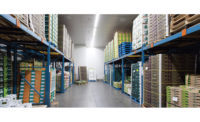5 ways LED reduces overhead refrigeration costs

Commercial refrigerator energy consumption costs can dig deep into the overhead of a facility with cold storage systems. The most practical path to this highly desired reduction in refrigeration costs is through the lighting system, more specifically with LED.
Lighting technology has made advancements over the past few years, allowing LED refrigeration lighting to provide an increasingly larger ROI when converting to LED. Since LED technology is versatile, uses less energy compared to other lighting technologies and maintains safe illumination levels, it enables operations involved with refrigeration systems of any size to gain the benefits that the ever-improving LED lighting technology provides.
Here are the five ways cold storage facilities can reduce overhead costs with quality LED cold storage lighting.
1. Decrease heat output. Heat produced by a lighting fixture is a result of an inefficiency in the light fixture. What this means is, that for all of the energy input into a light fixture that isn’t converted into visible light, it’s converted into heat. In today's marketplace, no lighting technology or product is entirely efficient at converting the energy input into light. As of today, LEDs convert most of its energy input into visible light, enabling them to output less heat and avoid excessive cooling to compensate for heat produced by the lighting system.
2. Pure energy savings. In today’s lighting market, LED is said to be up to 75% more efficient than metal halide, high-pressure sodium (HPS) or other HID light fixtures and nearly 35% more efficient than fluorescent lights, most commonly found in cold storage environments. As a result, by converting to LED cold storage lighting technology, companies can produce a positive return on their investment by converting from any of those lighting technologies to LED.
3. Less maintenance. Cold storage lighting systems can be intensive to maintain and replace, and any reduction in the amount of time needed to maintain a lighting system in this environment allows for a reduction in billable hours to maintain the system. To combat this, LEDs offer a virtually no-maintenance design and last from 50,000-100,000 hours, which is 2-3 times more than other lighting technologies. This increase in lifespan allows companies to buy fewer replacement luminaires and incur less maintenance fees.
4. Works in cold temperatures. LEDs are versatile in the way that they are able to work in very cold or very warm temperatures, between -30° to 50°C. The ability to operate in such low temperature is not commonly possible with other lights such as metal halide or HPS due to their design. In general, this helps reduce refrigeration costs simply by its ability to maintain a naturally long lifespan in such cold temperatures. This avoids excessive fixture replacement that can occur with other lights that can’t handle these extreme temperatures without deteriorating or working at their optimal levels.
5. Ability to lock out moisture. Premature failure with lighting systems in cold storage environments is commonly caused by the inability to lock out moisture, which will quickly destroy an otherwise perfect light. It is especially bad in environments like cold storage where the moisture gets in, freezes and expands; breaking internal components leaving the light useless. By having a quality and specifically designed light fixture made to lock out moisture, it enables a company to avoid the cost of replacing lights lost to moisture damaged. While this aspect isn’t LED specific, it’s important to note because without a quality place for the luminaire to be held in that keeps out moisture, it doesn’t matter what lighting technology you have because it will destroy it quickly either way.
Common issues that occur with lighting systems in a refrigerated environment is virtually eliminated with the use of LED technology built to suit these types of environments.
Looking for a reprint of this article?
From high-res PDFs to custom plaques, order your copy today!





